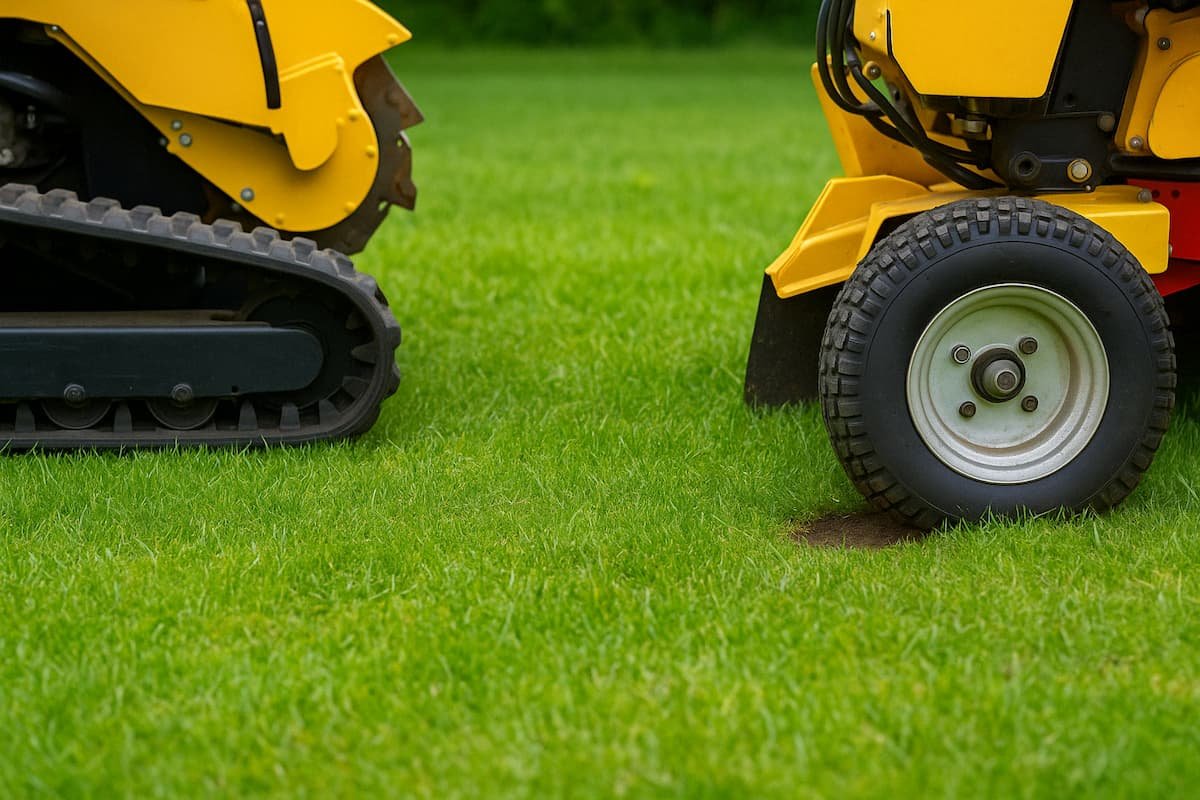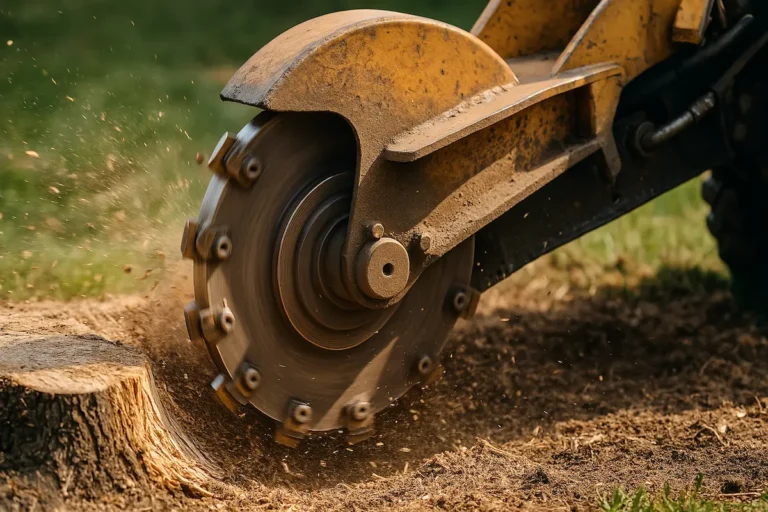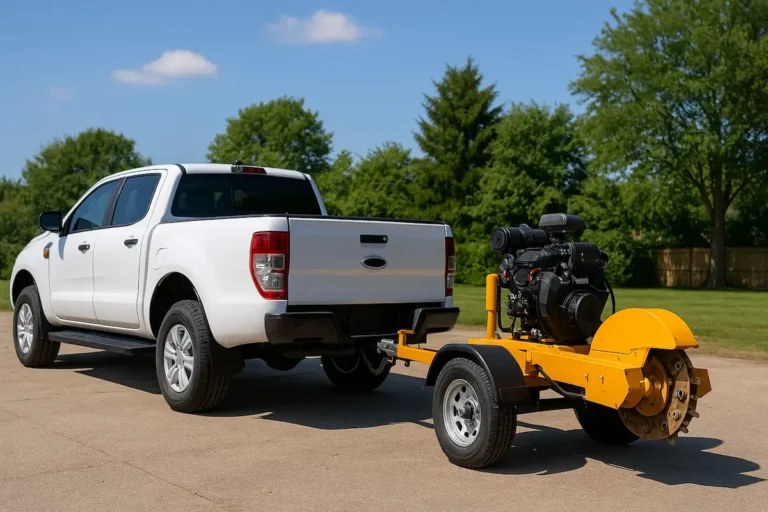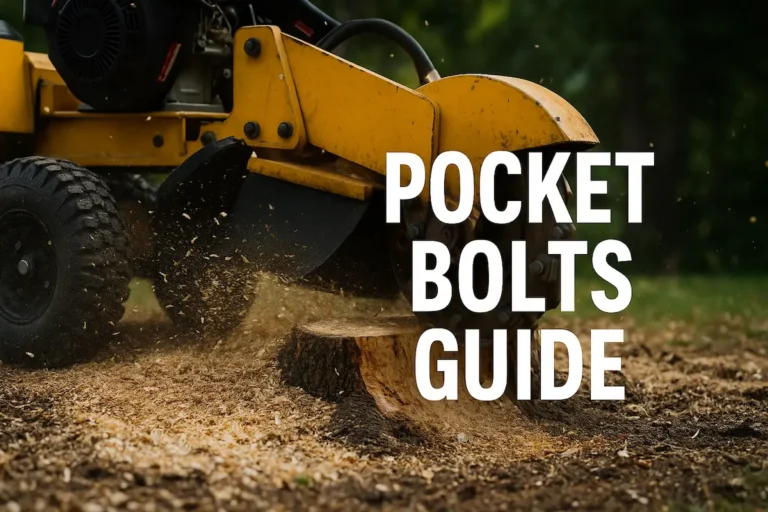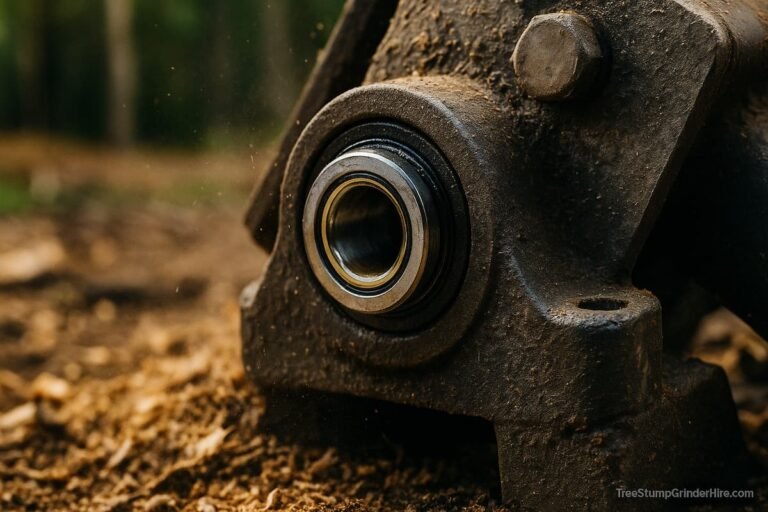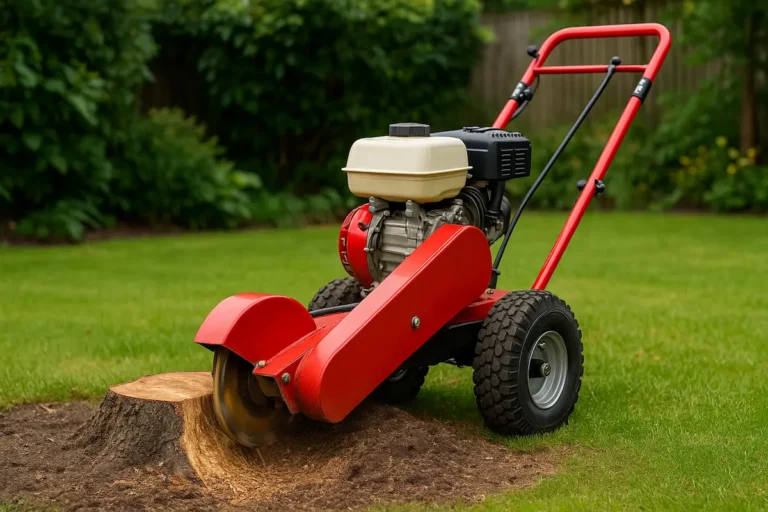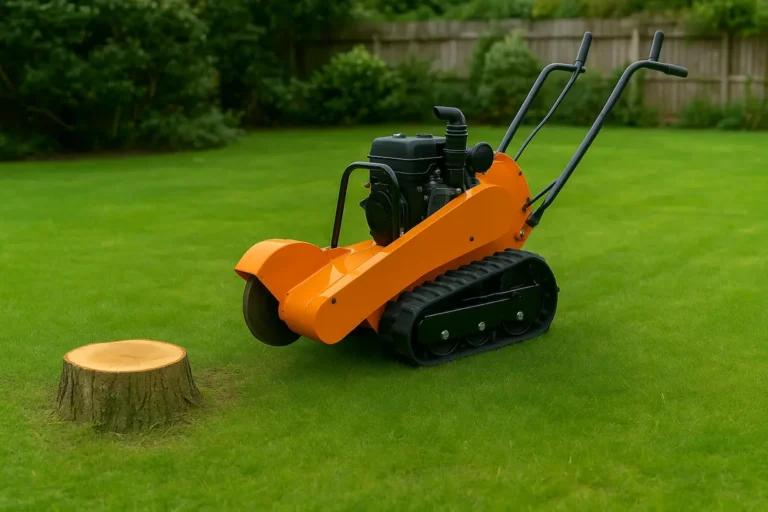Understanding Stump Grinder Ground Pressure: Protecting Your Property During Hire
Are you worried about garden damage when hiring a stump grinder?
Ground pressure is the key thing to know.
Low ground pressure means less chance of mess.
This guide explains it.
✅ Before You Hire a Stump Grinder:
- Check if the machine is tracked for low ground pressure.
- Confirm the PSI rating (aim for below 8 PSI).
- Ask if they use ground protection mats.
- Review the operator’s experience with sensitive areas.
- Discuss access paths over lawns, patios, or driveways.
- Schedule a site inspection if needed.
Why Ground Pressure Is Crucial When Hiring a Stump Grinder
Ground pressure matters most for protecting your property.
It tells you how much a machine presses down on the ground.
Too much pressure can cause problems.
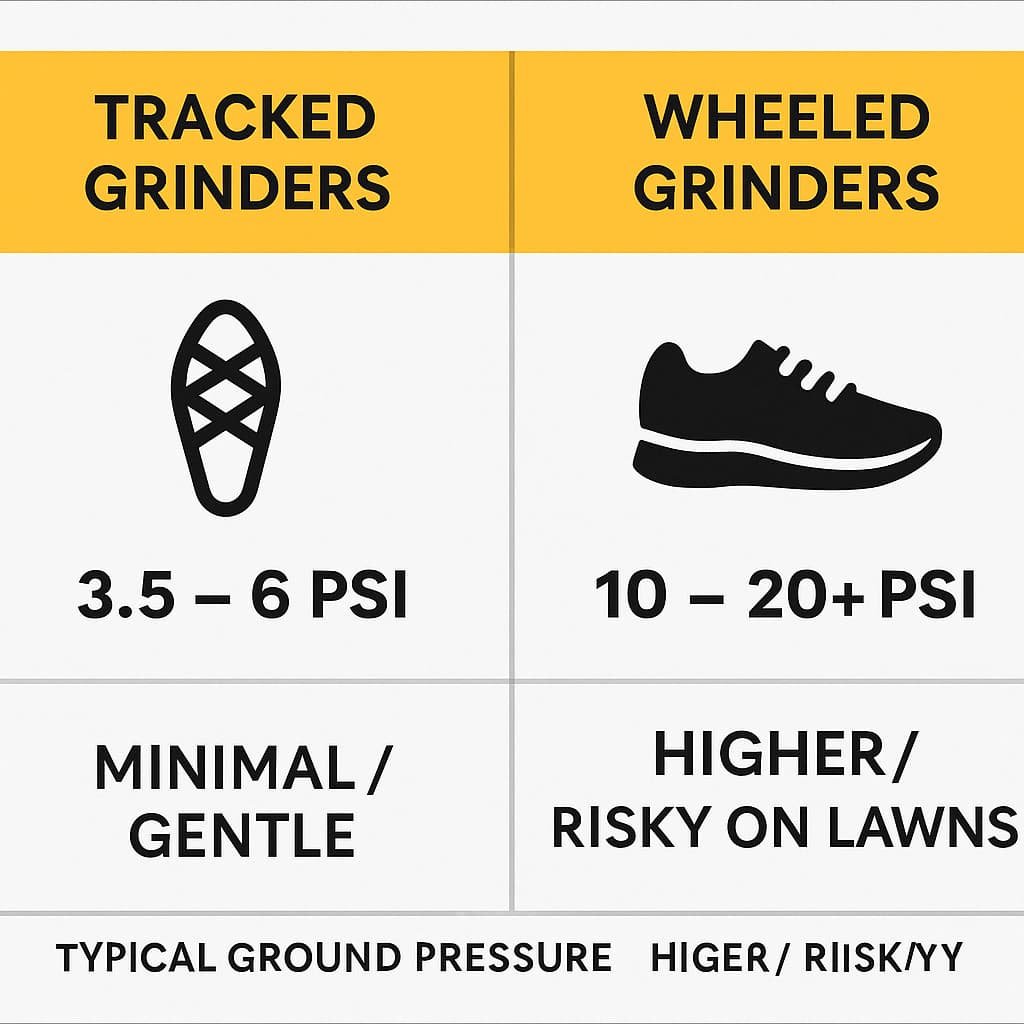
Preventing Damage to Your Lawn, Patio, and Driveway
You want the stump gone, not a damaged garden.
Heavy machines with high ground pressure can leave ugly marks.
They might make deep ruts in your soft lawn.
They could crack your patio slabs or driveway.
Pipes or wires under the ground might even get squashed.
Choosing a machine with low ground pressure helps stop this.
It spreads its weight out more gently.
This protects your surfaces from harm.
Ensuring Access to Difficult or Sensitive Areas
Sometimes, stumps are in tricky spots.
The only way in is across your best lawn.
Or perhaps the ground is soft or wet.
Machines with low ground pressure are better for this.
They can often go places heavier machines cannot.
They are less likely to get stuck or make a mess.
This means the job can get done even in sensitive areas.
How Low Ground Pressure Improves Your Hire Experience
Less damage means less stress for you.
You will be happier with the final result.
A clean job means a good hire experience.
Companies offering low-impact machines know this.
They focus on keeping your property looking good.
This leads to satisfied customers and better reviews.
Understanding Stump Grinder Ground Pressure
Key Takeaways from the Chart:
- Lower PSI is Better: Ground pressure, measured in Pounds per Square Inch (PSI), indicates how much weight a machine puts on the ground. Lower values mean less risk of damage to lawns, patios, or driveways.
- Tracked Grinders Excel: Tracked stump grinders typically have the lowest ground pressure (often 3.5 – 6 PSI), significantly less than an average human footprint (~8 PSI). This makes them ideal for sensitive areas.
- Wheeled Grinders Have Higher Impact: Wheeled stump grinders generally exert higher ground pressure (often starting at 10 PSI and going much higher), increasing the likelihood of ruts or surface damage, especially on soft ground.
- Context Matters: While low PSI is crucial for delicate surfaces, factors like operator skill and the use of ground protection mats also play a vital role in minimizing impact.
What Exactly Is Stump Grinder Ground Pressure?
So, what does ground pressure mean?
Think about how much something pushes down in one spot.
Defining Ground Pressure (PSI and kg/cm²)
Ground pressure measures how much a machine presses down on the surface.
It’s measured in:
- Pounds per square inch (PSI)
- Kilograms per square centimetre (kg/cm²)
Lower PSI = weight spread out more → gentler on surfaces.
We measure ground pressure using special units.
We often use pounds per square inch (PSI) in the UK.
Sometimes, you might see kilograms per square centimetre (kg/cm²).
It tells us the force spread over a small area.
Lower PSI means the weight is spread out more.
A higher PSI means the weight is focused on more minor spots.
For stump grinders, lower PSI is usually better for your garden.
Relating Ground Pressure to Everyday Examples (like a Footprint)
Let’s make it easier to understand.
Imagine walking on soft grass:
- Regular shoes → you sink slightly (~8 PSI).
- Snowshoes → you hardly sink at all (lower PSI).
Tracked stump grinders work like snowshoes: spreading weight gently.
Machines under 8 PSI are very lawn-friendly.
Your weight is pressing down through the soles of your shoes.
Now, think about wearing snowshoes in deep snow.
Snowshoes are big and spread your weight out.
You don’t sink in as much.
That’s like low-ground pressure.
Stump grinders work the same way.
Some spread their weight like snowshoes, others like small shoes.
Machines with pressure lower than 8 PSI are very gentle on lawns.
Key Factors Determining a Stump Grinder’s Ground Pressure
Several things decide how much ground pressure a machine has.
It is not just about how heavy the machine is.
Simple Comparison Graphic: Tracked vs. Wheeled Ground Pressure
Idea: A clean side-by-side graphic showing typical PSI ranges:
| Type | Typical Ground Pressure | Surface Impact |
|---|---|---|
| Tracked Grinders | 3.5 – 6 PSI | Minimal / Gentle |
| Wheeled Grinders | 10 – 20+ PSI | Higher / Risky on lawns |
The Direct Impact of Machine Weight
Heavier machines weigh more.
More weight means more force pushing down.
But weight alone doesn’t tell the whole story.
Tracks vs. Wheels: The Critical Difference in Surface Contact
This is the most crucial part, along with weight.
How does the machine touch the ground?
Tracked stump grinders have long tracks, like a tank.
These tracks cover a large area of ground.
They spread the machine’s weight over that big area.
This results in much lower ground pressure.
Wheeled stump grinders use tyres.
Tyres touch the ground on smaller patches.
All the machine’s weight pushes down on those small spots.
This usually means higher ground pressure.
Think again about shoes: tracks are like snowshoes, wheels are like regular shoes.
How Tyre Width and Inflation Affect Wheeled Models
For wheeled machines, the tyres make a difference.
Wider tyres have a bigger contact patch than narrow tyres.
A bigger patch can help spread the weight more.
How much air is in the tyres (inflation) also matters.
Lower tyre pressure can increase the contact area slightly.
Some bigger wheeled grinders use dual wheels (two wheels side-by-side).
This helps distribute the weight better than single wheels.
But generally, tracks still offer the lowest pressure.
The Influence of Machine Design and Weight Balance
How the machine is built also plays a part.
Where is the engine located? How is the weight spread out?
Good design balances the weight evenly.
This prevents too much pressure on one specific point.
The Advantage of Low Ground Pressure: Tracked Stump Grinders
Tracked stump grinders are often the best choice for protecting property.
They are designed to be gentle on the ground.
Typical Low PSI Ratings for Tracked Grinders (3.5 – 6 PSI)
Modern tracked grinders have very low ground pressure.
Many popular models have less pressure than a walking person.
Typical figures range from 3.5 PSI to 6 PSI.
This is significantly lower than the average human footprint of 8 PSI.
It shows how well they spread their weight.
Popular Low-Impact Models (Examples: Vermeer, Bandit, Carlton)
Several brands make excellent tracked grinders known for low impact.
- Vermeer: Models like the SC382 boast ground pressure around 4.1 PSI.
- Bandit: The ZT1844 model is known for pressure as low as 4.5 PSI.
- Carlton: Tracked models like the SP4012 are often praised for being gentle on lawns, generally under 5 PSI.
These figures come from the makers and user reviews.
They show these machines are built for sensitive areas.
Real-World Benefits: Traversing Lawns with Minimal Trace
Seeing is believing.
Many videos online show tracked grinders at work.
You can watch them moving across lovely lawns.
Often, they leave barely a mark behind.
Operators frequently point this out in the videos.
They show close-ups of the tracks moving over the grass without digging in.
This is especially true even on slightly damp ground.
The low PSI rating makes this possible.
It gives homeowners peace of mind.
Ground Pressure Considerations for Wheeled Stump Grinders
Wheeled stump grinders are also available for hire.
They can be good machines, but ground pressure is different.
Understanding the Higher Potential Ground Pressure
Wheeled machines focus their weight on the tyre contact points.
This usually means higher PSI compared to tracked models.
Smaller-wheeled grinders might still be pretty light.
But larger, ride-on-wheeled grinders can be quite heavy.
Their ground pressure can range from 10 PSI to over 20 PSI.
This depends heavily on the machine’s weight and tyres.
Manufacturers don’t always advertise the PSI for wheeled models as much.
This is because low impact is the main selling point for tracked versions.
Higher pressure means a greater risk of leaving ruts or marks.
This is especially true on soft ground or lovely lawns.
When Wheeled Grinders Can Be a Suitable Choice
Wheeled grinders can still be the right tool sometimes.
They might be faster to move around on hard surfaces.
They might be fine if the stump is on hard ground or soil.
Tracks might not be needed if access is only over concrete or tarmac.
Operator skill is essential with wheeled machines on soft ground.
Careful driving helps reduce damage.
Using ground protection mats is often essential with wheeled units on lawns.
Common Problems with High Ground Pressure
| Problem | Cause |
|---|---|
| Lawn Ruts | Deep tracks from heavy wheels |
| Soil Compaction | Squashed soil harms drainage |
| Patio Damage | Cracked or shifted pavers |
| Driveway Cracks | Asphalt or concrete cracking |
| Underground Damage | Crushed pipes or cables |
| Access Issues | Getting stuck on soft ground |
Evidence from the Field: Operator Insights on Ground Pressure
What do the professionals say?
Experienced tree workers share their knowledge online.
What YouTube Demonstrations Reveal About Lawn Impact
YouTube is full of videos showing stump grinders in action.
Search for ” tracked stump grinder on the lawn” or specific models.
You will see many examples of tracked machines working cleanly.
Operators often talk about how little mess the tracks make.
Some videos compare tracked and wheeled machines directly.
They clearly show tracks are gentler, especially when turning.
Wheeled machines can sometimes scuff the grass when steering.
You will also see the pros of using ground protection mats.
They use big plastic sheets or plywood boards.
They put these down even with low-PSI tracked machines.
This gives extra protection on perfect lawns or delicate paving.
It’s considered best practice for careful work.
Videos also show tracked machines climbing slopes easily.
They handle uneven ground better than some wheeled models.
Operators often say the low pressure gives them confidence.
They worry less about upsetting customers with lawn damage.
Professional Arborist Experiences (Forums & Social Media)
Tree care professionals discuss equipment online.
On forums like ArboristSite, tracks get lots of praise.
Operators often say tracked grinders save the hassle.
They get fewer complaints about lawn damage.
They mention models like Vermeer, Bandit, and Carlton track units.
They feel these machines justify a higher hire cost sometimes.
This is because they avoid repair work later.
One user might say something like:
“Got a tracked machine last year—big difference. Hardly any lawn repair is needed now. Can get it into tight spots I wouldn’t risk with my old wheeled one.”
Homeowners asking for advice on Reddit often hear the same thing.
People recommend asking hire companies about their machines.
They suggest asking for tracked grinders for delicate lawns.
Operators on social media often post photos.
They show their tracked machines working on neat gardens.
Captions often highlight “low impact” or “minimal disturbance“.
It shows pride in doing a tidy job.
Common Problems Summary Box
High-ground pressure from stump grinders can cause:
- Lawn Ruts: Deep, ugly tracks pressed into the grass, especially when wet.
- Soil Compaction: Squashing the soil, which harms lawn health and drainage.
- Patio/Paver Damage: Cracking or shifting of paving stones.
- Driveway Cracks: Damage to asphalt or concrete surfaces.
- Underground Damage: Risk to sprinkler systems or shallow utility lines.
- Access Issues: Inability to reach stumps across soft or sensitive ground.
Essential Strategies to Minimise Ground Impact During Grinding
Choosing the right machine is step one.
But there are other ways to protect your property.
The Vital Role of Ground Protection Mats
These are large, strong sheets, often made of plastic or wood.
Operators lay them down on the ground before driving the grinder over.
They spread the machine’s weight over an even larger area.
They protect the surface underneath from direct contact.
Ground protection mats are excellent for:
- Soft or wet lawns
- Decorative paving stones
- Driveways you want to keep perfect
- Areas where the machine needs to turn sharply
Even low-PSI-tracked machines benefit from mats on very sensitive surfaces.
Ask your hire company if they use them or offer them.
Using mats shows a commitment to careful work.
Importance of a Professional Site Assessment
Before starting, a good operator looks at the job site.
They check the ground conditions. Is it wet, dry, soft, or hard?
They look at the access route. What surfaces must the machine cross?
They identify any potential hazards like slopes or underground services.
This assessment helps choose the right machine.
It also plans the safest way to move the grinder.
It helps decide if ground mats are needed and where.
How Operator Skill Prevents Unnecessary Damage
The person driving the machine matters a lot.
A skilled operator knows how to handle the grinder smoothly.
They avoid sharp, fast turns that can scuff lawns.
They drive at a sensible speed.
They understand how the machine’s weight shifts when moving.
Even a low-ground pressure machine can cause damage if poorly driven.
Experience and care make a big difference.
Choose a hire company with experienced operators.
Choosing the Right Stump Grinder Hire for Your Property
Now you know about ground pressure, how do you choose?
Think about your specific garden and the stump’s location.
Matching the Machine to Your Ground Conditions (Wet, Soft, Sloped)
Consider the state of your ground.
- Wet or Soft Lawn: Prioritise a low-PSI tracked grinder. Wheeled machines will likely cause damage. Insist on ground mats, too.
- Sloped Ground: Tracked grinders often have better stability and traction on slopes. They are less likely to slip and damage the grass.
- Dry, Firm Lawn: A tracked grinder is still the safest option. However, a lighter-wheeled grinder might be okay with careful operation and possibly mats.
- Complex Soil/Rough Area: Ground pressure might be less critical here, but low PSI is never a disadvantage.
Assessing Access Routes Across Sensitive Surfaces
Think about how the machine will get to the stump.
- Across Perfect Lawn: Use a tracked grinder and ground protection mats.
- Across Pavers or Patio: Low PSI helps, but mats are essential to prevent scuffs and cracks. Choose the lightest suitable machine.
- Across Driveway: Mats are recommended, especially for tarmac, which can be marked by tyres or even tracks when turning.
- Through Narrow Gates: Check the width of the machine. Some compact tracked grinders are designed for tight access.
Talk to the hiring company about your access path.
Tell them about any surfaces you are worried about.
A good company will help you choose the best option.
Our Commitment to Low-Impact Stump Grinding at treestumpgrinderhire.com
We understand that protecting your property is vital.
We know you want the stump removed without extra mess or damage.
That’s why ground pressure is essential to us.
Offering a Fleet with Low Ground Pressure Options
We aim to provide machines suited for sensitive jobs.
Our listings include tracked stump grinders.
These machines offer impressively low ground pressure.
They help minimise the risk of lawn or path damage.
We provide information on the types of machines available.
This helps you find the right grinder for your needs.
Utilising Protective Measures as Standard Practice
Many of the professionals listed understand best practices.
They often use ground protection mats where needed.
Their operators are experienced in careful machine handling.
They conduct site checks to plan the work safely.
Our goal is to connect you with services that respect your property.
Low-impact grinding means a better result for you.
Your Questions Answered: Stump Grinder Ground Pressure FAQs
Here are some common questions:
- Q: Is ground pressure the only thing that matters for lawn damage?
- A: No. Operator skills and using ground mats are also critical. But low ground pressure gives the best starting point.
- Q: Are tracked grinders always better than wheeled ones?
- A: For low-ground impact on soft surfaces, yes, usually. Wheeled machines can be fine in other situations, especially on hard ground.
- Q: How low does the PSI need to be?
- A: Anything under the human footprint (around 8 PSI) is excellent. Many tracked machines achieve 3.5 to 6 PSI.
- Q: Will a tracked grinder leave no marks?
- A: They leave very minimal marks in most conditions. Slight marking is possible on extremely soft, wet ground or during sharp turns. Mats provide extra security.
- Q: Should I pay more to hire a tracked grinder?
- A: Sometimes, they cost slightly more to hire. But this can save you money and hassle by avoiding lawn repair costs later.
Summary: Hire with Confidence, Protect Your Property
Ground pressure is key to avoiding damage during stump grinding.
Machines with low PSI, especially tracked grinders, are gentlest on lawns.
They spread their weight out like snowshoes.
Typical tracked machines have 3.5 to 6 PSI, less than a person walking.
Wheeled machines usually have higher pressure.
Always consider the ground conditions and access route.
Using ground protection mats provides extra safety.
Experienced operators handle machines carefully.
Understanding ground pressure helps you make a wise hire choice.
You can get your stump removed without wrecking your garden.
Ready to find the right machine?

